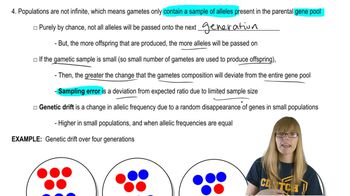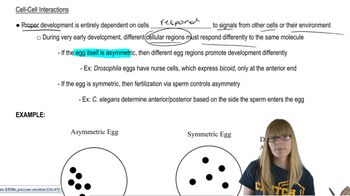In terms of molecular biology, what is a library?
Table of contents
- 1. Introduction to Genetics51m
- 2. Mendel's Laws of Inheritance3h 37m
- 3. Extensions to Mendelian Inheritance2h 41m
- 4. Genetic Mapping and Linkage2h 28m
- 5. Genetics of Bacteria and Viruses1h 21m
- 6. Chromosomal Variation1h 48m
- 7. DNA and Chromosome Structure56m
- 8. DNA Replication1h 10m
- 9. Mitosis and Meiosis1h 34m
- 10. Transcription1h 0m
- 11. Translation58m
- 12. Gene Regulation in Prokaryotes1h 19m
- 13. Gene Regulation in Eukaryotes44m
- 14. Genetic Control of Development44m
- 15. Genomes and Genomics1h 50m
- 16. Transposable Elements47m
- 17. Mutation, Repair, and Recombination1h 6m
- 18. Molecular Genetic Tools19m
- 19. Cancer Genetics29m
- 20. Quantitative Genetics1h 26m
- 21. Population Genetics50m
- 22. Evolutionary Genetics29m
18. Molecular Genetic Tools
Methods for Analyzing DNA
Problem 1b
Textbook Question
How does a positive ASO test for sickle-cell anemia determine that an individual is homozygous recessive for the mutation that causes sickle-cell anemia?
 Verified step by step guidance
Verified step by step guidance1
Understand the concept of an ASO (Allele-Specific Oligonucleotide) test: This test uses short DNA probes that are complementary to specific alleles of a gene. It can detect single nucleotide polymorphisms (SNPs) or mutations by hybridizing to the target DNA sequence under stringent conditions.
Review the genetic basis of sickle-cell anemia: The condition is caused by a mutation in the beta-globin gene (HBB), where a single nucleotide substitution (A to T) results in the production of abnormal hemoglobin (HbS). Individuals who are homozygous recessive (HbS/HbS) have two copies of the mutated allele.
Examine how the ASO test works for sickle-cell anemia: The test uses two probes—one specific to the normal allele (HbA) and one specific to the mutated allele (HbS). DNA from the individual is isolated and subjected to hybridization with these probes.
Interpret the results of the ASO test: If the DNA hybridizes only with the probe specific to the mutated allele (HbS) and not with the probe for the normal allele (HbA), this indicates that the individual is homozygous recessive for the sickle-cell mutation.
Conclude the reasoning: A positive ASO test for the sickle-cell mutation confirms that the individual has two copies of the mutated allele (HbS/HbS), which is the genetic basis for being homozygous recessive for sickle-cell anemia.
 Verified video answer for a similar problem:
Verified video answer for a similar problem:This video solution was recommended by our tutors as helpful for the problem above
Video duration:
54sPlay a video:
Was this helpful?
Key Concepts
Here are the essential concepts you must grasp in order to answer the question correctly.
Allele-Specific Oligonucleotide (ASO) Testing
ASO testing is a molecular technique used to detect specific mutations in DNA. It involves using short, labeled DNA probes that are complementary to the target mutation. If the target mutation is present in the individual's DNA, the probe will bind to it, indicating a positive result. This method is particularly useful for identifying homozygous recessive genotypes, as it can confirm the presence of two copies of the mutated allele.
Recommended video:
Guided course

Genetic Drift
Homozygous Recessive Genotype
A homozygous recessive genotype refers to having two identical alleles for a particular gene, both of which are recessive. In the case of sickle-cell anemia, the mutation in the HBB gene leads to the production of abnormal hemoglobin. An individual must inherit two copies of the mutated allele (one from each parent) to express the disease phenotype, which is confirmed through ASO testing when both alleles are detected.
Recommended video:
Guided course

Gamete Genotypes
Sickle-Cell Anemia Genetics
Sickle-cell anemia is a genetic disorder caused by a mutation in the HBB gene on chromosome 11, leading to the production of sickle-shaped red blood cells. This condition is inherited in an autosomal recessive manner, meaning that an individual must inherit two copies of the mutated gene to exhibit symptoms. Understanding the genetic basis of sickle-cell anemia is crucial for interpreting ASO test results and determining an individual's genotype.
Recommended video:
Guided course

Cell-cell interactions

 7:40m
7:40mWatch next
Master Methods for Analyzing DNA and RNA with a bite sized video explanation from Kylia
Start learningRelated Videos
Related Practice
Multiple Choice
480
views
3
rank
